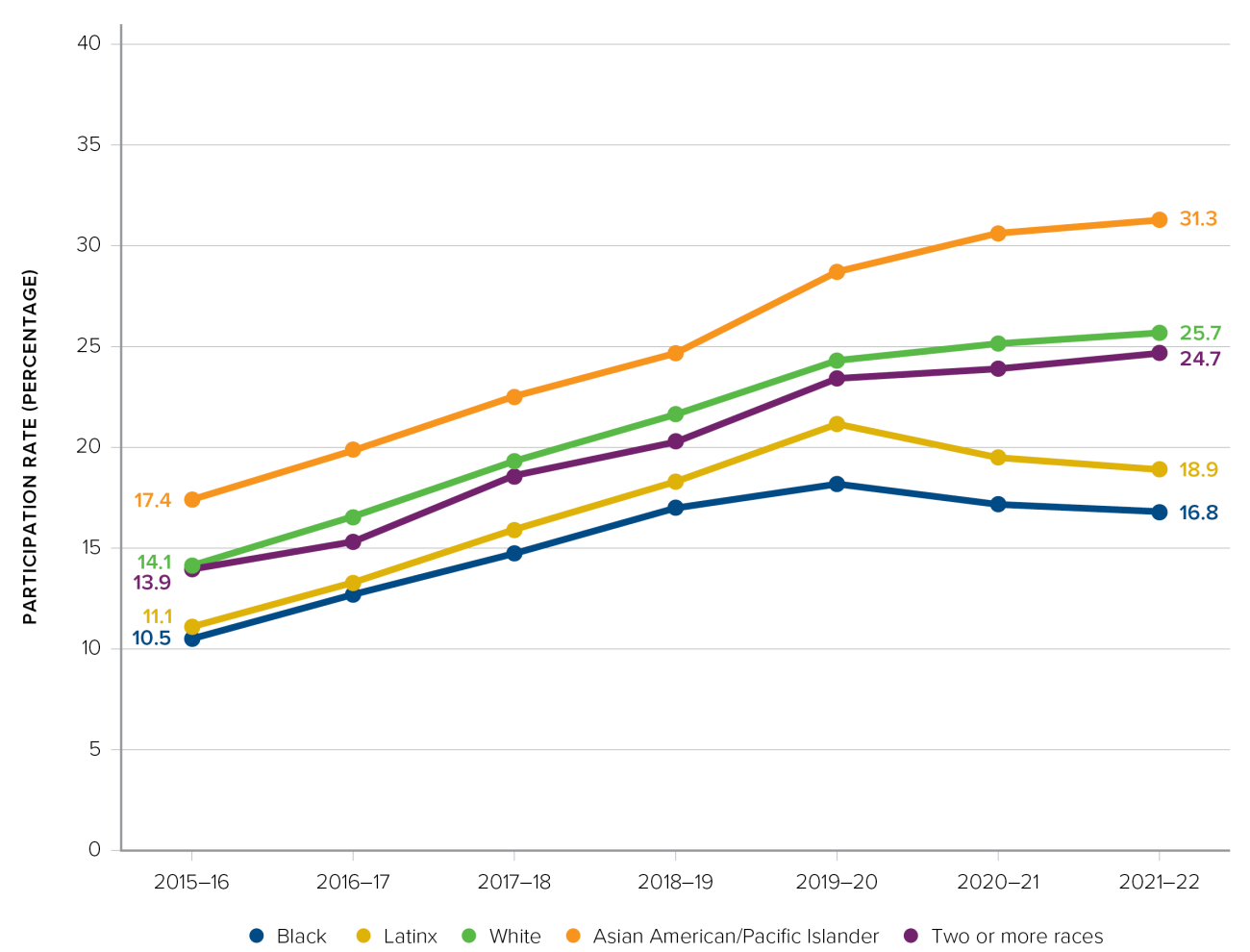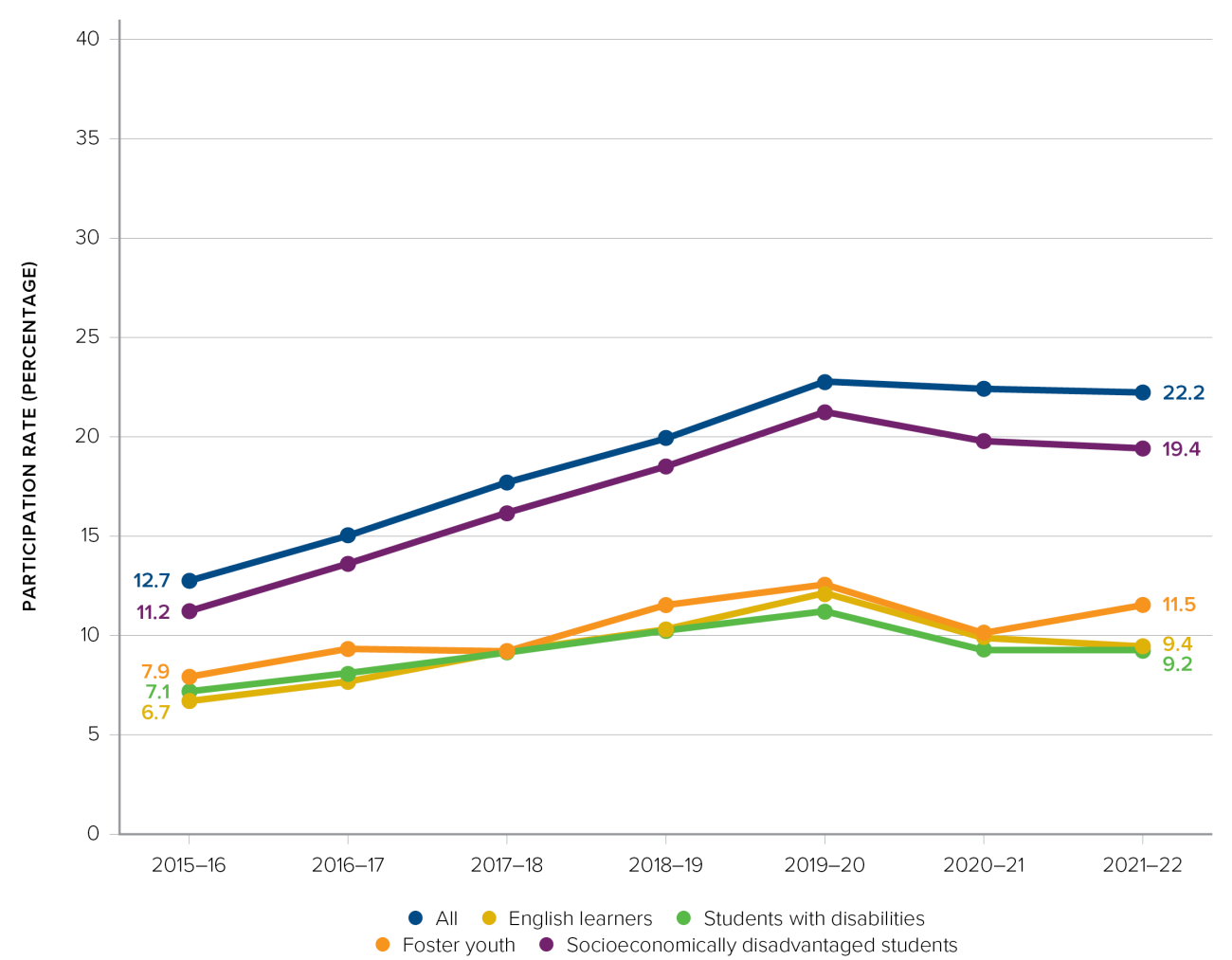Growth Interrupted

Summary
California policymakers and educators are increasingly turning to dual enrollment as a key mechanism for improving educational attainment and ensuring that students statewide have equal access to postsecondary opportunities.
In 2016, legislators paved the way for dual enrollment by enacting Assembly Bill (AB) 288, which aimed to facilitate collaboration between high schools and community colleges. Policymakers have also increased funding for the expansion of dual enrollment programs. At the local level, secondary and postsecondary educators in many communities are working together to offer college courses that meet students’ needs and interests, to enroll more students in dual enrollment, and to support students’ success in those courses. These efforts appeared to be paying off as participation increased steadily for the graduating cohorts in 2015–16 through 2019–20. For the first time in 5 years, though, statewide participation stagnated for high school graduates in 2020–21 and 2021–22, suggesting that the COVID-19 pandemic may have stemmed opportunities for dual enrollment.
Policy Context
California’s investment in dual enrollment includes $200 million annually in apportionment funding for high school students enrolled in community college courses and $1.8 million to support Middle College High Schools (MCHS).1 In 2018–19, the state allocated $10 million in one-time funding for the California STEM Pathways Grant program, which supports the creation of 6-year programs in which students in 9th through 12th grades take both high school and community college courses that lead to a high school diploma and an associate degree in a science, technology, engineering, or math field within 2 years of completing high school. In 2022, the state allocated an additional $200 million through AB 181 for competitive grant funding to expand dual enrollment opportunities alongside student support and advising services.
AB 288, enacted in 2016 and extended by AB 30 in 2019, paved the way for increased dual enrollment by promoting formalized partnerships—College and Career Access Pathways (CCAP) partnerships—between community colleges and high schools. This legislation allowed college classes to be taught on high school campuses exclusively for high school students, exempted high school students from having to pay tuition and fees, and focused on increasing participation of historically underserved students.
Dual enrollment participation nearly doubled between 2015–16 and 2019–20 but has since tapered off.
In recent years, nearly one quarter of the graduating cohort took a community college course during their 4 years of high school.2 Participation increased steadily, from 12.7 percent among the 2015–16 cohort to 22.8 percent among the 2019–20 cohort, and then leveled off for the cohorts graduating since the pandemic. This stagnation is not all that surprising given the widespread closure of high school and college campuses and the disruption within educational settings during the pandemic.
Figure 1. Dual Enrollment Participation by High School Graduating Cohort

Note. Since publication of A Rising Tide in 2020, we have improved our methods for matching high school students to the community college data, which has resulted in updated (slightly higher) participation rates than previously reported for the graduating cohorts of 2015–16 through 2018–19. For more information on the matching process, please contact the authors.
Despite growth in participation, equity gaps persist, and in some cases, gaps have widened since the pandemic.
Although dual enrollment participation rates rose steadily for all students between 2015–16 and 2019–20, notable gaps between racial/ethnic subgroups remained relatively unchanged. In the 3 years following 2019–20, these gaps widened. Participation among Asian/Pacific Islander students has continued to increase since the pandemic, as has the rate for White students and those who identify with two or more races, albeit more gradually. However, the percentage of Black and Latinx high school graduates who took a community college course in high school has declined since 2019–20. In 2015–16 and 2018–19, the gap between Asian/Pacific Islander students and Black students was about 7 percentage points; it doubled by 2021–22 to 14.5 percentage points.
Figure 2. Dual Enrollment Participation by High School Graduating Cohort and Racial/Ethnic Subgroup

Note. Racial/ethnic categories sourced from California Department of Education data.
Dual enrollment participation lags for students with educational disadvantages.
For students whose life circumstances, such as economic hardship, may inhibit educational pursuits, opportunities to enroll in community college while in high school may be less accessible. Dual enrollment participation rates among socioeconomically disadvantaged students, English learners, youth in foster care, and students with disabilities lag their nondisadvantaged peers. Although participation for these subgroups was increasing during the years preceding the pandemic, rates declined among more recent graduating cohorts.
Figure 3. Dual Enrollment Participation by High School Graduating Cohort and Student Subgroup

Note. Student subgroups sourced from California Department of Education data.
Discussion
Participation in dual enrollment is markedly higher for the 2021–22 cohort than it was for students graduating from California public high schools just 6 years prior—a pattern observed across racial/ethnic subgroups as well as for both socioeconomically disadvantaged students and youth in foster care. Despite this overall increase, growth in dual enrollment participation stagnated in the years following the COVID-19 pandemic (2021–2022) and slightly declined for Black, Latinx, and socioeconomically disadvantaged students from their peak participation rates among the class of 2020. These patterns are consistent with research documenting the impact of educational disruptions during the pandemic that exacerbated inequality.3 Nevertheless, the overall growth in dual enrollment participation suggests that the state’s investments and educators’ efforts are generally paying off. Moreover, recent research indicates that formal dual enrollment opportunities—whether defined as CCAP courses or community college courses that enroll only high school students—result in more equitable participation, particularly for early grade high school students, and that these opportunities are increasing.4 When considered in this context, the recent stagnation—and decline for some subgroups—in dual enrollment participation should not be viewed as discouraging news. Instead, these results should be leveraged as a call to continue to develop and strengthen dual enrollment programs and to prioritize equitable access since these programs can be transformative for students, offering an affordable head start for college as well as fostering workforce and economic development.
Measuring Dual Enrollment
Investigation of dual enrollment participation requires linking data from high school and postsecondary systems. The results reported here draw on a match of two separate data sets:
- student-level data from the California Department of Education for the census of public high school 12th graders enrolled on April 15 of each academic year between 2015–16 and 2021–22 and
- student-level course-taking data from the California Community Colleges Chancellor’s Office between fall 2012 and spring 2022.
In our publications, we have reported dual enrollment participation in two distinct ways.
- Participation of a high school graduating cohort: For this method, we construct cohorts of high school seniors expected to graduate each year. We merge the individual students in each cohort to community college course data for the 4 normative years of high school attendance. For example, the graduating cohort of 2018–19 includes 12th graders expected to graduate in 2019; we investigate their community college course taking between fall 2015 and spring 2019. This strategy allows us to examine how many high school graduates took a community college course at any time during their high school tenure. Research findings from this methodology were reported in A Foot in the Door, A Rising Tide, and A Leg Up on College.
- Participation among all high school students in a given year: For this snapshot in time, we merge student- level data for all students in grades 9 through 12 in a given academic year (e.g., 2021–22) to student-level community college course-taking data from the same year (e.g., summer 2021 to spring 2022). This method shows how many high school students participated in dual enrollment at a specific point in time. Results from this approach were reported in A Strong Start for College and Career.
Limitations: This analysis does not capture dual enrollment that may be occurring with the California State University or the University of California.
The research reported here was supported by the Stuart Foundation; the Institute of Education Sciences, U.S. Department of Education, through Grant R305A210217 to the Regents of the University of California; and the University of California’s Multicampus Research Programs and Initiatives funding. The California Education Lab, Wheelhouse, and PACE are grateful to College Futures Foundation and the Bill & Melinda Gates Foundation for supporting dissemination as well as to the California Department of Education and the California Community Colleges Chancellor’s Office for providing the data necessary for the analysis. The findings and conclusions here are those of the authors and do not necessarily reflect positions or policies of funders or advisers.
- 1
As defined by the California Department of Education, “MCHS are secondary schools located on a college campus. These schools offer challenging academic programs designed to serve high-potential, high-risk students. MCHS feature effective support services, small class size, and the opportunity for students to concurrently take some college classes at a typically minor cost to the student.” California Department of Education. (2023). Middle college high school. cde.ca.gov/fg/fo/r17/documents/mcec24rfa.docx
- 2
We define a graduating cohort as all students who completed high school in a given year, and we construct the sample from the high school completer data file provided by the California Department of Education through our data-sharing agreement (PI, Michal Kurlaender). We have examined dual enrollment participation using seven other methods for constructing a high school graduating cohort, and the patterns are consistent across cohort definitions.
- 3
Gee, K. A., Asmundson, V., & Vang, T. (2023). Educational impacts of the COVID-19 pandemic in the United States: Inequities by race, ethnicity, and socioeconomic status. Current Opinion in Psychology, 52, 101643. doi.org/10.1016/j.copsyc.2023.101643; Hough, H. J., & Chavez, B. (2024, January). California test scores show little improvement after pandemic [Policy brief]. Policy Analysis for California Education. edpolicyinca.org/publications/california-test-scores-show-little-improvement-after-pandemic
- 4
Friedmann, E., Reed, S., Kurlaender, M., & Dykeman, K. A. (2024, February). A strong start for college and career: Dual enrollment participation from 9th to 12th grade [Infographic]. Policy Analysis for California Education. edpolicyinca.org/publications/strong-start-college-and-career; Kurlaender, M., Reed, S., Grosz, M., Mathias, J., & Hughes, K. (2021, October). A foot in the door: Growth in participation and equity in dual enrollment in California [Research brief]. UC Davis Wheelhouse: The Center for Community College Leadership and Research. education.ucdavis.edu/sites/main/files/wheelhouse_research_brief_ vol_6_no_7_final.pdf; Rodriguez, O., & Gao, N. (2021, October). Dual enrollment in California: Promoting equitable student access and success [Report]. Public Policy Institute of California. ppic.org/publication/dual-enrollment-in-california
Dykeman, K. A., Bennett, S. R., Friedmann, E., & Kurlaender, M. (2024, June). Growth interrupted: An update on dual enrollment participation among public high school graduates [Infographic]. Policy Analysis for California Education. https://edpolicyinca.org/publications/growth-interruptedtions/transition-college



